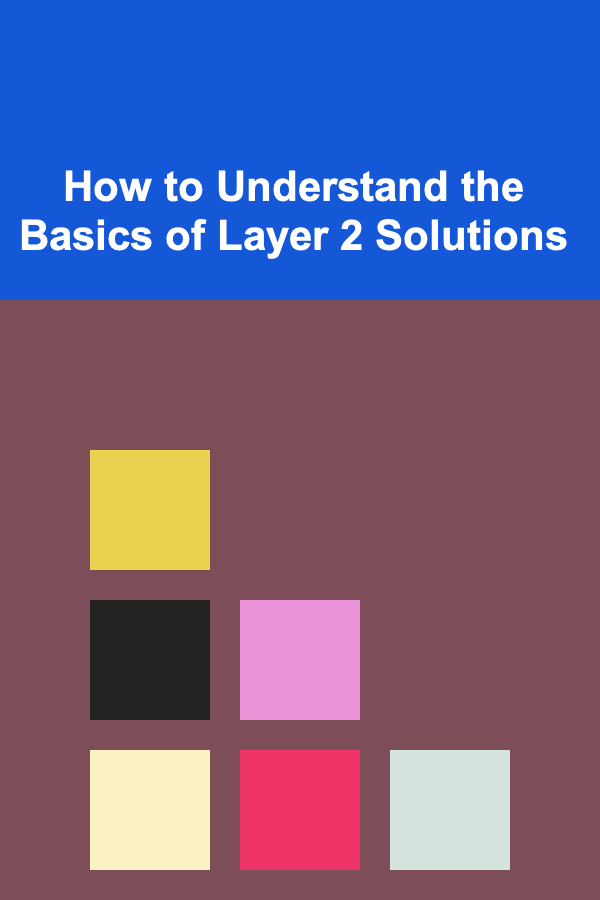
How to Understand the Basics of Layer 2 Solutions
ebook include PDF & Audio bundle (Micro Guide)
$12.99$10.99
Limited Time Offer! Order within the next:

In recent years, the term "Layer 2" has become one of the most discussed topics in the world of blockchain technology. As the demand for blockchain scalability increases, solutions like Layer 2 are being explored to solve inherent limitations of Layer 1 blockchains. But what exactly is Layer 2, and how can we understand its role in blockchain systems?
This article will delve into the core aspects of Layer 2 solutions, explaining their significance, how they work, the different types of Layer 2 technologies, and why they matter for the future of blockchain scalability.
What Are Layer 1 and Layer 2 in Blockchain?
Before diving into Layer 2 solutions, it's important to understand the foundational concepts of Layer 1 and Layer 2. Blockchain architecture is often represented in a layered model, with Layer 1 being the base layer and Layer 2 being a secondary layer built on top of it.
- Layer 1 refers to the base layer of the blockchain, which is responsible for maintaining the integrity of the network, ensuring security, and validating transactions. Examples of Layer 1 blockchains include Bitcoin, Ethereum, and Solana. These blockchains typically rely on consensus mechanisms (like Proof of Work or Proof of Stake) to secure the network.
- Layer 2 solutions, on the other hand, are protocols built on top of Layer 1 that aim to address scalability issues by offloading transactions from the main blockchain. Layer 2 solutions operate independently of the base layer's security but rely on the underlying blockchain for final settlement and security.
In simpler terms, Layer 2 enhances Layer 1 by improving its efficiency, scalability, and transaction speed. This is crucial because Layer 1 blockchains can struggle with processing a high number of transactions per second (TPS), which leads to network congestion and high fees. Layer 2 solves these challenges by taking some of the transaction load off the main chain.
Why Do We Need Layer 2 Solutions?
The rise in blockchain adoption, particularly with decentralized applications (dApps) and decentralized finance (DeFi), has brought about significant scalability challenges. Let's explore why Layer 2 solutions are essential in this context:
2.1 Scalability Challenges on Layer 1
Layer 1 blockchains have a fixed block size and processing capacity. For instance, Bitcoin's transaction throughput is about 7 transactions per second (TPS), and Ethereum's is around 15-30 TPS, far less than centralized payment systems like Visa, which can handle over 24,000 TPS.
As the demand for blockchain usage grows, these base layers become congested, leading to slower transactions, higher fees, and inefficiencies in the network. Since blockchain transactions are immutable and decentralized, they need to be processed and validated in a way that ensures security. But the more transactions that are processed, the more expensive and slower they become on the main chain.
2.2 The Solution: Layer 2
Layer 2 solutions are designed to address these scalability issues. By processing transactions off-chain or through sidechains, they reduce the burden on Layer 1 blockchains, allowing for higher throughput, faster transaction speeds, and lower fees.
In short, Layer 2 allows blockchain networks to handle a much larger volume of transactions without sacrificing the core principles of decentralization and security. This is achieved by relying on different methods, such as off-chain transactions, aggregating multiple transactions into one, or using novel consensus mechanisms for sidechains.
How Do Layer 2 Solutions Work?
Layer 2 solutions essentially extend the functionality of the underlying blockchain (Layer 1) while keeping the base layer's integrity intact. Below are some common methods by which Layer 2 solutions operate:
3.1 State Channels
A state channel is one of the most common Layer 2 solutions used to improve transaction throughput. In a state channel, two or more participants can conduct multiple off-chain transactions, with the results only being settled on the blockchain once the participants choose to close the channel.
The process works as follows:
- Two participants open a state channel by creating a smart contract on the Layer 1 blockchain.
- They can now conduct off-chain transactions with minimal costs, as the updates to the state (i.e., the balance of accounts or assets) are only recorded off-chain.
- Once the participants are done with their transactions, they can settle the final state on the main blockchain, submitting only the final result of the interaction.
The key benefits of state channels include:
- Low transaction costs: Only the opening and closing transactions need to be recorded on the main chain, reducing the cost of each transaction.
- Fast transactions: Transactions within the state channel can happen almost instantly.
- Scalability: Since transactions are off-chain, the scalability of the network increases.
However, state channels are more suitable for applications where participants expect to interact many times, such as gaming or micropayments.
3.2 Plasma
Plasma is another Layer 2 solution that leverages the concept of "child chains." Plasma involves creating smaller, hierarchical blockchains that are tethered to the main blockchain. These child chains can process transactions independently, and only certain data is periodically submitted to the main chain.
How Plasma works:
- Plasma creates child chains that can process transactions more quickly than the main blockchain.
- The child chains periodically submit summary data or root hashes to the Layer 1 blockchain to ensure the integrity of the network.
- If users or participants in the child chain wish to exit or challenge a transaction, they can submit proof to the Layer 1 blockchain, which will validate the correctness of the child chain's operations.
Plasma is a highly scalable solution, but it is more complex compared to state channels and requires additional infrastructure and smart contract complexity. It's most suitable for use cases like token transfers or decentralized exchanges (DEX).
3.3 Rollups
Rollups are one of the most promising Layer 2 technologies. Rollups involve executing transactions outside the main chain, but all transaction data is bundled (or "rolled up") and posted to the Layer 1 chain in batches.
There are two main types of rollups:
- Optimistic Rollups: These assume that transactions are valid by default and only check for fraud when a challenge is raised. Optimistic rollups can handle a high throughput of transactions with minimal delays and are currently the most widely used Layer 2 technology for Ethereum.
- Zero-Knowledge Rollups (zk-Rollups): zk-Rollups use zero-knowledge proofs to ensure that transactions are valid without revealing sensitive data. These are more complex but offer stronger security guarantees than optimistic rollups.
The benefits of rollups include:
- Higher throughput: By bundling multiple transactions, rollups can significantly increase the transaction capacity of the network.
- Reduced fees: Because multiple transactions are grouped together, the cost per transaction is reduced.
- Security: Rollups inherit the security of the base layer, ensuring the safety and finality of transactions.
3.4 Sidechains
A sidechain is an independent blockchain that is connected to the main blockchain via a two-way peg. The idea behind sidechains is to offload transactions from the main chain onto the sidechain, allowing the sidechain to have its own consensus mechanism, block times, and rules.
Sidechains can be particularly useful for testing new features or applications without disrupting the main chain. They also allow for more flexibility in terms of transaction rules, such as faster block times or different cryptographic algorithms.
The key advantages of sidechains include:
- Customizability: Sidechains can have different rules and consensus mechanisms compared to the main chain.
- Scalability: By offloading transactions to a sidechain, the main chain is less congested.
- Interoperability: Sidechains can interact with other blockchains, making them useful for cross-chain applications.
However, sidechains may not offer the same level of security as the main chain, as they rely on their own consensus mechanism.
Popular Layer 2 Solutions
Some Layer 2 solutions have gained widespread adoption in the blockchain ecosystem. These include:
4.1 Lightning Network (Bitcoin)
The Lightning Network is a Layer 2 solution for Bitcoin that uses payment channels to enable fast, low-cost transactions. It is widely regarded as one of the most successful Layer 2 solutions for Bitcoin.
4.2 Optimism (Ethereum)
Optimism is an optimistic rollup solution for Ethereum that aims to improve scalability while maintaining Ethereum's security. It has gained significant traction within the Ethereum community and is often used for DeFi applications.
4.3 Arbitrum (Ethereum)
Arbitrum is another rollup-based Layer 2 solution for Ethereum. It uses optimistic rollups to offer high throughput, low fees, and compatibility with Ethereum's existing smart contracts.
4.4 Polygon (Ethereum)
Polygon is a Layer 2 solution that combines multiple technologies, including sidechains, Plasma, and rollups, to improve the scalability and speed of Ethereum. It has become one of the most popular Layer 2 platforms for decentralized applications.
The Future of Layer 2 Solutions
The future of Layer 2 solutions looks promising, as they offer a way to scale blockchain networks without compromising decentralization or security. As blockchain adoption continues to grow, Layer 2 will play an increasingly important role in enabling mass adoption and ensuring that blockchain technology remains viable for large-scale applications.
In the coming years, we can expect further advancements in Layer 2 technologies, including:
- Improved interoperability between Layer 1 and Layer 2 networks.
- Increased adoption of rollups and state channels.
- The development of new consensus mechanisms that enable even more efficient Layer 2 solutions.
Layer 2 solutions are critical to the growth of blockchain technology, and understanding how they work is essential for anyone involved in the blockchain space.
Conclusion
Layer 2 solutions are the key to solving the scalability problems that have plagued Layer 1 blockchains. By using technologies like state channels, Plasma, rollups, and sidechains, Layer 2 enables higher transaction throughput, reduced fees, and faster processing times. While each solution has its strengths and weaknesses, they all share the goal of improving blockchain scalability without sacrificing security or decentralization.
As blockchain networks continue to evolve, Layer 2 solutions will be essential for unlocking the full potential of decentralized technologies, supporting the growing demand for dApps, DeFi, and other blockchain-based services.

How to Avoid Common Money Mistakes in Your 20s
Read More
How to Build an Investment Strategy for Your Short-Term Goals
Read More
How to Make Your Home Feel Like a Holiday Getaway with Simple Decor
Read More
How to Use Under-Cabinet Storage in the Kitchen
Read More
Conquering Shyness: Your Guide to Confident Language Speaking
Read More
Choosing the Best Birding Backpack: A Comprehensive Guide
Read MoreOther Products

How to Avoid Common Money Mistakes in Your 20s
Read More
How to Build an Investment Strategy for Your Short-Term Goals
Read More
How to Make Your Home Feel Like a Holiday Getaway with Simple Decor
Read More
How to Use Under-Cabinet Storage in the Kitchen
Read More
Conquering Shyness: Your Guide to Confident Language Speaking
Read More